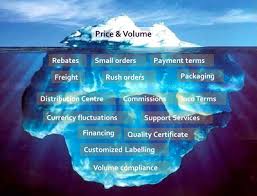What additional or hidden costs might lie under the surface of ex works that shall influence total cost at the point of consumption?
It’s easy to award a supplier business based on its ex works offer being the cheapest or most cost competitive offer received at the end of a tendering event. In a lot of cases this may be the case and if all bidders reside in the same general geographic area and provide similar levels of service. Even delivered price offers may be very similar; provides the buyer with the easier option in that the responsibility to arrange and provide delivery resides with the supplier, therefore a task less for the buyer’ organisation to arrange.
Ex works price, invariably being most visible to the buyer can therefore singularly influence sourcing award.
In many cases, though, ex works can be the tip of what can be called the ‘Priceberg’; the total lump of cost that constitutes what the organisation shall have had to pay for at the point of consumption. In terms of add on elements these shall lurk under the surface of ex works price tip. Dependent on particular circumstances or influencers there may be many of these that the buyer ought to have knowledge, or at least an understanding of what the add-on elements may be, are these to be classed as tangible or intangible, then how much shall the sum influence final cost at the point of use. Pricebergs differ from their polar brethren, where ex works (the tip) may make up 80% of total cost, however the 20% remaining cost shall be made up of the 80% total amount of add-on costs.
In analysing or identifying these additions it may be prudent to split them in to tangible and intangible costs. Let’s look at examples of both separately.
Tangible
Inbound Duty
Goods being bought from overseas may very likely be liable for inbound duty that might not be able to be fiscally reclaimed if the ultimate point of use resides within the sovereign territory of the buyer’s organisation. Different regions/trading blocs may apply different duty rates for imports of the same types of goods; can range from as little as 5% to as much as 80% (and may be even more).
Delivery (INCO) Terms
Nothing gets delivered for free! Granted the buyer may not be required to organise freight and the payment of for delivered priced goods, however the cost to deliver has already been factored in to the price by the supplier. Delivered price is an INCO term and as well as ex works is one of 13 that cover road, air and sea freight. Dependent on what is being bought and from where these shall all carry a cost for final delivery that requires to be understood and captured. Additionally the buyer should be very aware of what specific INCO term shall be best suited to purchased goods to best manage this cost. INCO term agreed may mandate the buyer to take out additional shipping insurance as protection against any accidents that might occur during goods transit and after hand over by supplier.
Quality Surveillance
Should the goods being procured require staged or witness point inspection during the WIP phase of manufacture then a final inspection requirement prior to approval sign off and sale to the buyer, this activity shall in all likelihood require inspection work to be undertaken by a 3rd Party that shall be a cost of purchase. It may also very well be that an /the inspector may require to be 100% resident in the supplier’s facility whilst the ordered goods are being made.
Warehousing
A consequence of importing goods may be that these require to be held in a separate warehouse prior to being receipted then released for use, for varying reasons that may not apply if the same goods were more locally sourced. The supplier may not be expected to stump up for this.
Intangible
Payment Terms
In many cases where INCO Terms demand payment before the goods physically leave the supplier’s facility or port of departure, goods may require to be paid for by anything up to 2-3 months prior to receipt, if being shipped from (say) EEC to Australia. The cost to the buyer would then be what that spent money may have earned in bank interest should payment terms have been net 30 days if procured locally. Lost interest would require to factor the period of time in transit, then additionally the period of time between goods receipt and 30 day payment period.
Transactional Costs
When procuring from overseas the requirement to issue much more detailed Purchase Orders then process and manage documents received from those suppliers might be much more rigorous or in depth than what would require to be undertaken with the local supplier.
Supplier Management
Due to the geographical distance between the supplier’s and buyer’s facilities the requirement for much closer or intensive management of the supplier may be required that could mean anything up to physical site visits by buyer’s personnel to ensure things are happening as per delivery plan and especially if there is a lengthy lead-time between goods order and despatch.
Caveat Emptor
I covered add on costs in a prior blog “Procuring From Australia Pty”. The above selection provides some criteria. There shall be many more, depending on the nature of your business and need to be recognised, costs estimated and included in final pricing analysis. To ignore these would mean negligence on the part of the buyer.








